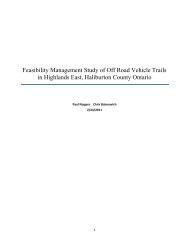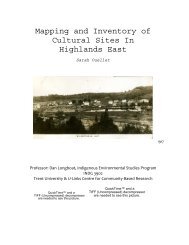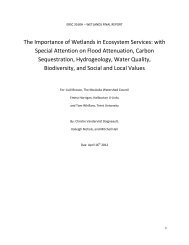Untitled - Haliburton County Community Cooperative Inc
Untitled - Haliburton County Community Cooperative Inc
Untitled - Haliburton County Community Cooperative Inc
- No tags were found...
Create successful ePaper yourself
Turn your PDF publications into a flip-book with our unique Google optimized e-Paper software.
esponded and from there the data underwent spatial stratification in order to estimate the informationthat will be presented in the following paragraphs.Zone 15 has a surface area of 37,700,000 hectares which is roughly 3.5% of all of the fishingzones in Ontario. Zone 15 is average size when compared to the 20 zones that Ontario is divided intoand yet contains 407 unique water bodies, which is the most out of any zone. The typical angler in thearea is a male with an approximate age of 45 which is one of the lowest average ages of all zones. Theseanglers spent nearly 19 days fishing and invested nearly 4 hours per day which translates to 76 hours peryear invested in zone 15. This means that 7,500,000 hours have been invested in angling in 2005 or 22hours per hectare making it one of the heavier fished zones in Ontario. In fact, only zones 16, 17 and 18had higher intensities and those areas are Guelph, Kawartha Lakes and Eastern Ontario respectively andonly the Kawartha Lakes region has a dramatically higher intensity. Ontarians make up 93% of theanglers in zone 15, 1% is from other provinces and 6% are from other countries. This trend indicatesthat the majority of the money brought into zone 15 is from resident anglers, which in turn means thatthe residents are investing into the local economy. This is fairly significant as it helps secure theeconomy by investing into local industries and businessesIn 2005, roughly 7.1 million fish were caught in the zone and 1.2 million fish wereharvested and kept. Based on the number of fish caught in the zone, it is the 6 th most productive zonein Ontario. It has the highest proportion of small mouth bass caught in all regions with 27% of the 7.1million fish caught. It has the second highest proportion of largemouth bass caught and the thirdhighest for panfish. Please refer to figure 1 to view the species composition for all fish caught in zone15. Evidently, these species make up the vast majority of the fish caught in the area and therefore theeconomic success of the fishing industry in this area are highly dependent on the success of these fishspecies. The trend for fish harvested is very similar to that of the proportion of fish caught. The smallmouth bass proportion of fish harvested of 14% is tied for the third largest proportion in Ontario. The5







